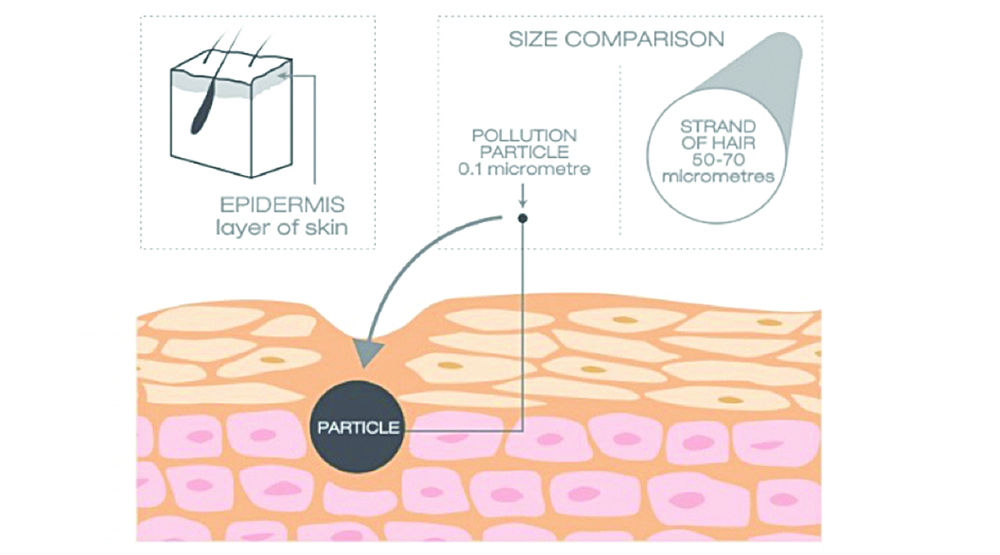What does it mean for the skin and what can we do to protect and treat ourselves against it?
We have known for some time about the risks of UV and sun exposure however, recent studies have identified pollution as an additional source of skin damage. Scientific studies have shown that as well as pollution accelerating ageing, there is a strong link between pollution and a number of other skin concerns such as; acne, congestion, cellulite, pigmentation and rosacea. Unlike sunburn, damage resulting from exposure to pollution does not present an immediate response, increasing the danger because we are unaware of the damage it is causing.
Alarmingly the amount of physical pollution present in our environment today is worse than it has ever been. London’s Oxford Street has the worst pollution in the world with levels of nitrogen dioxide up to 10 times the legal limit.
In 2018 it was announced that more than 80 percent of people living in urban areas are exposed to air quality levels that don’t meet World Health Organisation standards.
Air pollution causes more deaths worldwide than AIDS, diabetes and road injuries combined and is responsible for one in eight deaths globally.
How does pollution damage the skin?
The dirt particles, which are 20 times smaller than the diameter of a pore and therefore not visible to the human eye, cause the most harm to skin.
Due to their size, pollution particles are able to infiltrate the deeper layers of the epidermis, which can cause inflammation and dehydration.
These damaging environmental agents have a very irritating effect and once they penetrate the skin, they activate multiple pathways of inflammation, including melanocytes.
However, the good news is that steps can be taken to prevent and remove pollution from the skin and with innovative ingredients there are now products available that can help correct and treat damage caused by pollution.
Step 1: Remove
Clean the skin thoroughly! Think about the dirty film that builds up on your car between washes. That same film is building up on your skin – you just don’t see it.
We know we should clean our face, but many of us don’t do it that well or are not consistent.
In the morning, cleanse and exfoliate in order to prep skin for radiance-boosting products. At night, you need to thoroughly remove the film of potentially harmful pollutants, not to mention makeup and everyday dirt and sweat.
Cleansing alone is not enough, we need to exfoliate. Removing dead skin cells doesn’t make your skin thinner, the exact opposite is true – it makes the deep dermal layer of the skin thicker and not only provides a better barrier to pollution, it makes it less likely to develop fine lines and wrinkles. So what are the different levels of exfoliation available?
Chemical exfoliants will contain mild acids or enzymes. When these ingredients are applied to skin, they gently dissolve the ‘glue’ that cements dead skin cells together. This also helps remove any pollution that is potentially trapped in between the dead skin cells at the same time.
Chemical exfoliation can be achieved daily by using a cleanser formulation with AHAs or at a deeper level in a clinic with a chemical mask or peel treatment.
The next level of exfoliation is physical; ideally use a daily facial exfoliation product that contains environmentally friendly beads that are gentle enough to be used daily.
The final level of exfoliation is mechanical exfoliation and is an in-clinic treatment such as microdermabrasion or laser that will provide a much deeper and more effective exfoliation of dead skin cells and pollution.
Step 2: Correct
To correct the damage caused by pollution, it is critical that your skin care regime is packed with anti-oxidants at scientifically proven levels.
Antioxidants are without question the most powerful ingredients to diminish the visible damage of pollution. This is because antioxidants help to intercept the damage before it can have a significant impact on skin.
It requires a range of potent antioxidants to safeguard skin from the visible effects of pollution. This is because different antioxidants work against the different processes in which various types of pollutants harm the skin. The best protection is leave-on products with the broadest range of antioxidants. It is essential to protect your skin with antioxidants 24 hours a day. Pollution is all around us and knows no barriers.
Step 3: Protect
The final step is to protect from pollution. Look for products that contain anti-pollution ingredients. Ingredients that help improve the skin barrier function are ideal. Swertia Chriata uses stem cell technology to enable increased skin renewal. This combined with telomere technology and peptides help regenerate the skin and help reduce the appearance of fine lines and wrinkles, which are accelerated by pollution. Niacinamide is another key ingredient to look out for, it is scientifically proven to:
- reduce water loss, improve hydration and increase the skin barrier
- treat pigmentation; providing a more even skin tone,
- provides lightening and brightening effect on the skin
- can assist in the prevention of sunspots and reduce the risk of skin cancers
- help treat rosacea, redness and blotchiness in the skin
The final step in protection is ensuring the application of a physical shield in the form of a good quality mineral makeup which produces an effect like a protective mesh, protecting against the initial penetration of particles.
* Carley Stewart is the managing director of ASAP Skin Products

